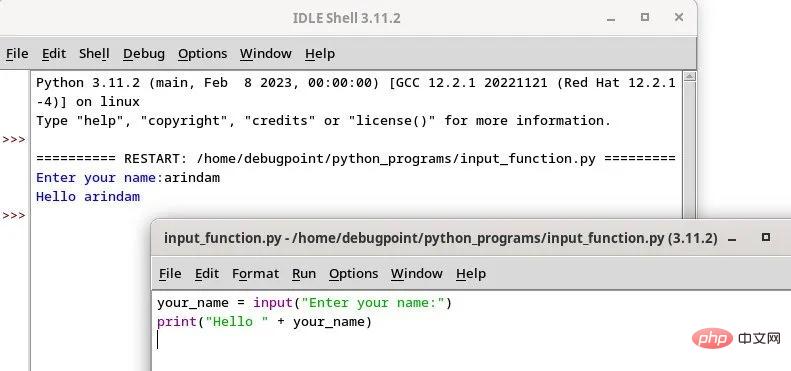Python 中的輸入函數:概念與範例
- 王林轉載
- 2023-04-12 16:28:061814瀏覽

Python 是世界上最受歡迎的程式語言之一,廣泛應用於各種應用程式。 Python 中的一個基本概念是 input() 函數,它允許使用者透過提供輸入值與程式進行互動。
讓我們看看 input() 函數是如何運作的,以及如何在 Python 程式中有效地使用它。
在開始之前,我希望你已經安裝了 Python 並設定了一個基本的編輯器。如果沒有,請參考我的以下指南:
- 如何在Windows 上安裝Python
- #Python
如何為Python 設定IDLE 編輯器
Python Input 函數
input()
函數用於接受使用者輸入的字串。它提示用戶輸入一個值並等待用戶提供輸入。然後將使用者的輸入作為字串儲存在變數中,稍後可以在程式中使用。句法
input("your message to user")當你執行 input() 函數時,它會向使用者顯示訊息並 等待 輸入。顯示遊標等待。當使用者輸入並按下回車鍵,input()
函數就會讀取使用者的輸入。該值儲存在你指定的變數中。 讓我們來看幾個例子。 範例1:簡單的input() 函數用法以下程式碼片段接受輸入並顯示附加字串的輸出:your_name = input("Enter your name:")
print("Hello " + your_name) 輸出:
輸出:Enter your name:arindamHello arindam
Python 輸入函數:一個簡單的範例
範例2:以整數和浮點數作為輸入在使用input() 函數時,你也可以在執行時使用 int()
float()
no_of_books = int(input("Enter total books ordered:"))
print ("Total number of books:", no_of_books)
price_of_each_book = float(input("Enter unit price:"))
print ("Total price:", no_of_books * price_of_each_book)輸出:Enter total books ordered:5 Total number of books: 5 Enter unit price:10.1 Total price: 50.5範例3:連接列表你也可以使用其他函數(例如列表)來接受一組值並將它們轉換為Python 中的
列表。這是一個接受輸入並將其轉換為列表的範例。然後使用另一組值並附加到第一個列表:
# 获取第一个列表的输入
list_1 = list(input("Enter numbers for list 1:"))
# 获取第二个列表的输入
list_2 = list(input("Enter some letters for list 2:"))
# 循环遍历第二个列表并添加到第一个列表
for j in list_2:
list_1.append(j)
# 打印修改后的第一个列表
print(list_1)輸出:###Enter numbers for list 1:1234 Enter some letters for list 2:ABCD ['1', '2', '3', '4', 'A', 'B', 'C', 'D']###總結######我希望這個簡單的指南透過幾個範例闡明了 ###input()### 函數。對於簡單的場景,它是一個強大的功能,可以從標準輸入中接受值。 ###
以上是Python 中的輸入函數:概念與範例的詳細內容。更多資訊請關注PHP中文網其他相關文章!
陳述:
本文轉載於:51cto.com。如有侵權,請聯絡admin@php.cn刪除

